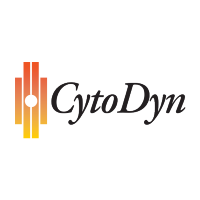

CytoDyn is a clinical-stage biotechnology company focused on the development and commercialization of leronlimab, an investigational humanized IgG4 monoclonal antibody (mAb) that is designed to bind to C-C chemokine receptor type 5 (CCR5), a protein on the surface of certain immune system cells that... CytoDyn is a clinical-stage biotechnology company focused on the development and commercialization of leronlimab, an investigational humanized IgG4 monoclonal antibody (mAb) that is designed to bind to C-C chemokine receptor type 5 (CCR5), a protein on the surface of certain immune system cells that is believed to play a role in numerous disease processes. CytoDyn is studying leronlimab in multiple therapeutic areas, including infectious disease, cancer, and autoimmune conditions. Show more
| Period | Change | Change % | Open | High | Low | Avg. Daily Vol | VWAP | |
|---|---|---|---|---|---|---|---|---|
| 1 | 0.0125 | 5.84112149533 | 0.214 | 0.235 | 0.198 | 2140732 | 0.2039473 | CS |
| 4 | -0.0235 | -9.4 | 0.25 | 0.2536 | 0.1925 | 1675476 | 0.21784482 | CS |
| 12 | -0.0134 | -5.58566069195 | 0.2399 | 0.4945 | 0.1761 | 3182831 | 0.25598672 | CS |
| 26 | 0.0765 | 51 | 0.15 | 0.4945 | 0.1031 | 2997294 | 0.19714848 | CS |
| 52 | 0.0715 | 46.1290322581 | 0.155 | 0.4945 | 0.1031 | 2707715 | 0.1785612 | CS |
| 156 | -0.0135 | -5.625 | 0.24 | 1.3 | 0.1031 | 2219530 | 0.26884421 | CS |
| 260 | -2.4235 | -91.4528301887 | 2.65 | 10.01 | 0.1031 | 2961648 | 1.91759653 | CS |
 chumppunk
10 hours ago
chumppunk
10 hours ago
 djjazzyjeff
12 hours ago
djjazzyjeff
12 hours ago
 Since 2012
12 hours ago
Since 2012
12 hours ago
 nunaka
13 hours ago
nunaka
13 hours ago
 theswordman
1 day ago
theswordman
1 day ago
 theswordman
2 days ago
theswordman
2 days ago
 Since 2012
5 days ago
Since 2012
5 days ago
 Niknak1
5 days ago
Niknak1
5 days ago
 kgromax
5 days ago
kgromax
5 days ago
 kgromax
5 days ago
kgromax
5 days ago
 theswordman
5 days ago
theswordman
5 days ago
 djjazzyjeff
6 days ago
djjazzyjeff
6 days ago
 chumppunk
6 days ago
chumppunk
6 days ago
 theswordman
7 days ago
theswordman
7 days ago
 theswordman
7 days ago
theswordman
7 days ago
 Since 2012
7 days ago
Since 2012
7 days ago
 kgromax
7 days ago
kgromax
7 days ago
 kgromax
7 days ago
kgromax
7 days ago
 Yahsho
1 week ago
Yahsho
1 week ago
 Yahsho
1 week ago
Yahsho
1 week ago
 djjazzyjeff
1 week ago
djjazzyjeff
1 week ago
 djjazzyjeff
1 week ago
djjazzyjeff
1 week ago
 djjazzyjeff
1 week ago
djjazzyjeff
1 week ago
 djjazzyjeff
1 week ago
djjazzyjeff
1 week ago
 djjazzyjeff
1 week ago
djjazzyjeff
1 week ago
 chumppunk
1 week ago
chumppunk
1 week ago
 kgromax
1 week ago
kgromax
1 week ago
 kgromax
1 week ago
kgromax
1 week ago
 chumppunk
1 week ago
chumppunk
1 week ago
 Blueheel1
1 week ago
Blueheel1
1 week ago
 docj
1 week ago
docj
1 week ago
 moneycrew
1 week ago
moneycrew
1 week ago
 djjazzyjeff
1 week ago
djjazzyjeff
1 week ago
 moneycrew
1 week ago
moneycrew
1 week ago
 kgromax
1 week ago
kgromax
1 week ago
 chumppunk
1 week ago
chumppunk
1 week ago
 djjazzyjeff
2 weeks ago
djjazzyjeff
2 weeks ago
 theswordman
2 weeks ago
theswordman
2 weeks ago
 Niknak1
2 weeks ago
Niknak1
2 weeks ago

It looks like you are not logged in. Click the button below to log in and keep track of your recent history.